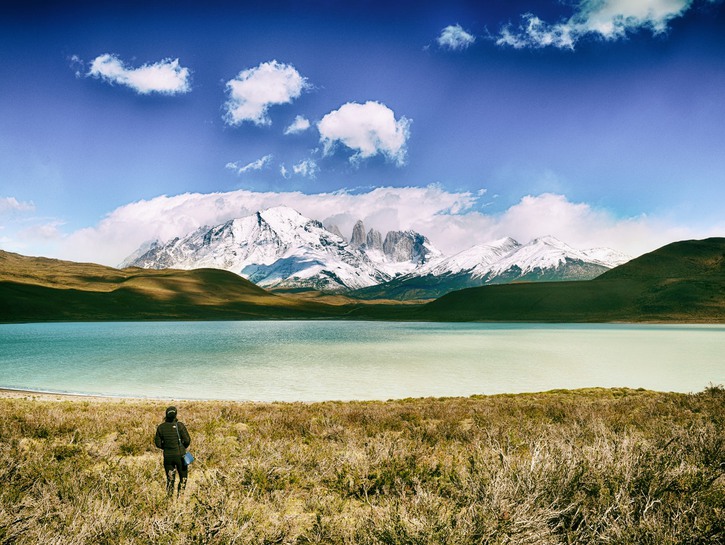
Spend the night in an Ewok village, bathe in the world’s largest swimming pool, and ride the elevator cars in the city once known as “The Jewel of The Pacific.” Welcome to Chile!
Videos by TravelAwaits
1. The Big Swim
San Alfonso del Mar is home to the largest swimming pool in the world. The pool was opened to the public in 2006 after taking over five years to build. It was engineered by Chilean biochemist Fernando Fischmann and his company Crystal Lagoons Corporations. This impressive artificial paradise is estimated to have cost between $1.5 and $2 billion to build and eats up close to $2 million is annual maintenance. The filtration system alone is rumored to have cost $3.5 million.
San Alfonso del Mar is located in Algarrobo, Chile just off the beach of the Pacific Ocean. The pool is 1,013 ft long and covers roughly 20 acres. Salt water from the sea is filtered and treated before being pumped into the pool. The pool contains 66 million gallons of seawater at a maximum depth of 11.5 ft. The water is cleaned and filtered once again before being returned to the Pacific Ocean. If you aren’t in the mood for a dip, San Alfonso del Mar rents small sailboats and paddleboats to visitors.
2. Elevators Of Valparaiso
If you’re visiting the coastal city of Valparaiso, it’s hard to miss the old elevator cars the line the city’s hillsides. The elevators of Valparaiso are curious artifacts of the city’s more prosperous past. The first elevator car was installed in 1911. At the time, the cars were the only way for residents to commute promptly to the city below. The cars look like a mix between a San Francisco trolley and the elevators of an old mining town.
The city of Valparaiso was once referred to by sailors as “Little San Francisco” and “The Jewel of the Pacific.” It was a prestigious port town and home to some of the country’s wealthiest families. The city’s economy experienced a sharp decline when the Panama Canal opened in 1914, diverting the bulk of the shipping traffic to the north.
In the last 15 years, Valparaiso has been making a comeback as a cultural center.
Its residents live perched on the many rolling hills that huddle against the coastline. The elevators began to fall into disrepair following the opening of the Panama Canal. Today, only 15 cars remain in operation, but they’re still the cheapest way to make it up the city’s hills. Be sure to bring cash, coins especially. A trip up the hill will cost you roughly 50 cents American.

The Elevators Of Valparaiso.
3. Dancing In Santiago
It’s hard to visit Chile without passing through Santiago. The city offers plenty of opportunities to get your dance on. Try your hand (and feet) at some salsa or tango. Tango’s birthplace is in Argentina, but that hasn’t stopped its migration into the heart of Chile.
Dancing can be a great way to shake your body loose after a long plane or car ride. Check out Havana Salsa for classes and socials or Ile Havana for live music and dancing. You can find traditional tango music at Buenos Aires Tango Club. Take the Bellas Artes, Patronato, or Los Leones Metro to Havana Salsa or the Cementerios, Irarrázaval, Santa Isabel Metro to visit the Buenos Aires Tango Club.
If you’re in the mood for a taste of home, Santiago has a popular Jazz scene too. Club de Jazz is one of the city’s most well-known jazz clubs. Other venues around town include Thelonious, Bar Grez, and the Jazz Corner.
4. The Hotel Nothofagus
The Hotel Nothofagus rises out of the rainforest in the town of Panguipulli in southern Chile. If you’ve ever wondered what it would be like to live like a Lord of the Rings character, the Hotel Nothofagus can give you a glimpse. Nothofagus is seven stories tall and made entirely of wood. The hotel’s 55 suites wrap around a central atrium, with a single tree stretching all seven stories to the glass-dome ceiling above. Climb the stairs or take the elevator to the roof where you can enjoy a stunning view of the nearby Choshuenco, one of Chile’s 500+ active volcanoes. The Hotel Nothofagus is located next door to the Montana Magica Lodge in southern Chile, not far from the Argentinian border. It’s 1.7 miles northwest of Puerto Fue by car.

Hotel Nothofagus. Booking.com
5. The Ba’Hai Temple Of South America
The Ba’Hai Faith celebrates universal harmony and religious tolerance. Its teachings began in the middle east but have since spread across the globe. Worship and educational centers are located in Uganda, Australia, the United States, Panama, Australia, Samoa, India, Cambodia, and now Santiago, Chile.
In 2002, the National Spiritual Assembly of the Ba’Hais of Chile announced a competition to design the new temple. Construction began in November of 2010, and it was completed in 2016. The structure’s futuristic design is composed of nine translucent panels of marble and glass. The panels drape over the dome-shaped structure like soft leaves. The temple can hold up to 600 visitors at a time, and the leaders of the Ba’Hai faith invite you to be one of them.
Chile stretches 2,670 miles, making it the longest country in the world from north to south. Whether you feel like sleeping amongst the trees of Panguipulli, or want to taste the ocean’s salty breeze, we can guarantee you’ll you won’t be bored!

